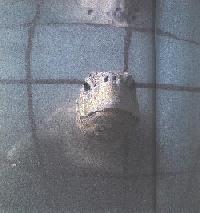

 Based on the results of preliminary research (LAZAR & TVRTKOVI], 1995), from 336
marine turtles found in fishermen nets in total, even 85% were caught by bottom trawling
(mostly for benthic fishes). In majority, the specimens were between 40 - 100 cm in length, and
were captured in the "winter period" between November and May. Although for 90% of
specimens caught by the trawlers is unknown if they were captured dead or alive, it seems that
mostly turtles were brought to the surface alive. In that case turtles are generally released by
fishermen, but sometimes are used for carapace preparation, and very rarely for domestic
consumption. Nevertheless, marine turtles' meat was included on a price-list in some
unpublished statistical reports between 1895 and 1987.
In the Italian waters even 62 - 87% marine turtles are captured by drifting longliners for
swordfish, and only 6% by trawlers (COCO et al., 1988; ARGANO et al., 1992). But, according
to the figure of records from COCCO at al. (1988) paper, it is obvious that the majority of a few
data from North and Central Italian waters is based on the trawling results.
Based on the results of preliminary research (LAZAR & TVRTKOVI], 1995), from 336
marine turtles found in fishermen nets in total, even 85% were caught by bottom trawling
(mostly for benthic fishes). In majority, the specimens were between 40 - 100 cm in length, and
were captured in the "winter period" between November and May. Although for 90% of
specimens caught by the trawlers is unknown if they were captured dead or alive, it seems that
mostly turtles were brought to the surface alive. In that case turtles are generally released by
fishermen, but sometimes are used for carapace preparation, and very rarely for domestic
consumption. Nevertheless, marine turtles' meat was included on a price-list in some
unpublished statistical reports between 1895 and 1987.
In the Italian waters even 62 - 87% marine turtles are captured by drifting longliners for
swordfish, and only 6% by trawlers (COCO et al., 1988; ARGANO et al., 1992). But, according
to the figure of records from COCCO at al. (1988) paper, it is obvious that the majority of a few
data from North and Central Italian waters is based on the trawling results.
Also, based on the results of the Greece Marine Turtles Tagging Project carried out at the Zakynthos bay and west coast of Peloponesus, from the 34 recaptured specimens of total post-nesting tagged females, 17 were recorded in the Golf of Gabes (Tunisia), and 6 in the Adriatic Sea (MARGARITOULIS, 1988). As there is no systematic collecting data about recaptures of tagged turtles in the eastern Adriatic, it is likely that the number in this area is higher. Probably marine turtles are coming into the Adriatic Sea from the Zakynthos island direction, following the stream along the east Adriatic coast (ARGANO et al., 1992). It is also interesting that the marine turtles overwintering area is discovered in the Gulf of Gabes, thanks to data based on accidental catches by trawlers (LAURENT & LESCURE, 1994). Further, GROOMBRIDGE (1986) suggest the possibility of the existence of the marine turtles' overwintering areas even in the North Adriatic, but without precise data. According to results of accidental catches it is not impossible that the overwintering actually occurs in the channels of Dalmatia.
Furthermore, new and detailed analysis of incidental catch (LAZAR, 1995) even more
support this theory: Analysis was carried out on 96 specimens caught by fishermen (15
Loggerheads, Caretta caretta and 81 unidentified specimens of the fam. Cheloniidae). Data were
gathered through questionnaire forms.

Ninety four turtles were captured in fishermen nets, mostly by trawlers (66 ex., 70,2%),
generally in deepness of 20 to 50 m (62 specimens). All turtles were captured on the muddy or
sandy sea bottom. Sixty seven specimens (71.3%) were caught during the "winter period"
(between November and May), 62 of which by bottom trawling. Although the activity of animals
in that period is still unknown, such high number of incidental catch of marine turtles during the
winter by trawlers indicate the possibility of existence of overwintering areas in the eastern part
of the Adriatic Sea. In most cases, precise length of carapace is unknown (66%), but it seems
that ratio between caught subadults (<70 cm) and adults (>70 cm) is quite equal (18 ex.: 14 ex.).
Turtles were generally captured alive, only 4 specimens were brought dead to the surface.
For the eastern Adriatic, 594 boats and ships are registered as commercial ships, 407 of
which are trawlers (approx. 75%)(CETINIĆ, 1989). Information collected during field research
and by talking to professional fishermen, made it possible to estimate the number of accidentally
caught marine turtles, during trawling operations. Yearly accidental catches per trawler reported
by professional fishermen from the northern Adriatic amount to about 10 specimens. The
number reported from the central and southern Adriatic is between two and four. Based on 218
trawlers from the northern Adriatic and 189 trawlers from the central and southern Adriatic
(CETINIĆ, 1989), we estimated, for the whole research aquatorium, at least 2,500 marine turtles
accidentally caught per year (LAZAR & TVRTKOVI], 1995).
A
lso, according to professional fishermen, the number of turtles caught or seen has
decreased in the last 10 years.
